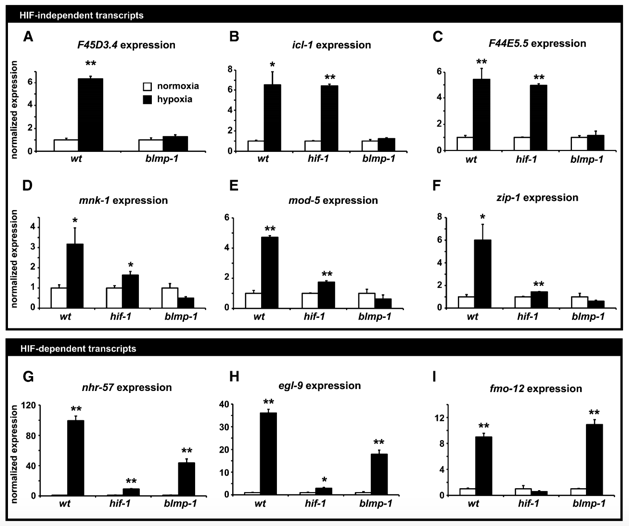Hif-dependent transcripts were also tested. These transcripts include: nhr-57, elg-9, and fmo-12 (used as a positive control). In these cases, when blmp-1 is turned off, the expression of the transcripts are not affected. This shows that blmp-1 only affects a certain class of responses to hypoxic conditions. This specific class being hif-independent responses. The results displayed in the figure were collected through a method of qPCR (see more under the support pages).
Padmanabha D, Padilla PA, You Y, Baker KD (2015)
A HIF-Independent Mediator of Transcriptional Responses to Oxygen
by Deprivation in Caenorhabditis Elegans
Genetics, Vol. 199, 739-748
A HIF-Independent Mediator of Transcriptional Responses to Oxygen
by Deprivation in Caenorhabditis Elegans
Genetics, Vol. 199, 739-748
(Translated by Emaan Chaudry)
Is blmp-1 mediating hypoxic responsiveness?
Experiment four confirmed that blmp-1 is one of the factors that is mediating hypoxic and cobalt chloride responsiveness. Therefore, blmp-1 mutants (worms with inactive blmp-1) were used to test the importance and function of blmp-1. This experiment looked at the expression of several known HIF-independent transcripts (F45D3.4, icl-1, F44E5.5, mnk-1, mod5, zip-1). The hypotehsis is that by eliminating blmp-1, these transcripts will not respond under hypoxic conditions (like they normally should be). This is caused because blmp-1 is one of the mediators that allows these genes to be transcribed in hypoxic conditions. This is exactly what was found in the results (seen in figure 3 of the paper). The control animals responded by upregulating all of the transcripts under hypoxic conditions. When hif-1 mutants are tested (animals with inactive hif-1 pathways), the expression is lowered. When the blmp-1 mutants are tested, the expression is lowered even more under hypoxic conditions.
| 
Figure 3: This is taken directly from Padmenhaba et al (2015). It displays the difference in the expression of various genes in hypoxic versus normoxic conditions in wild type, hif-1 mutant and blmp-1 mutant round worms.
|